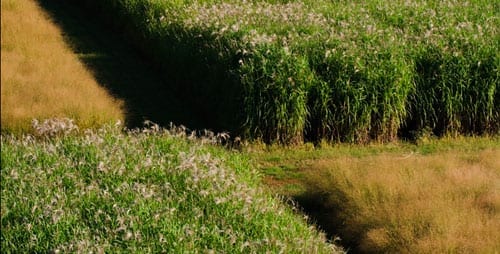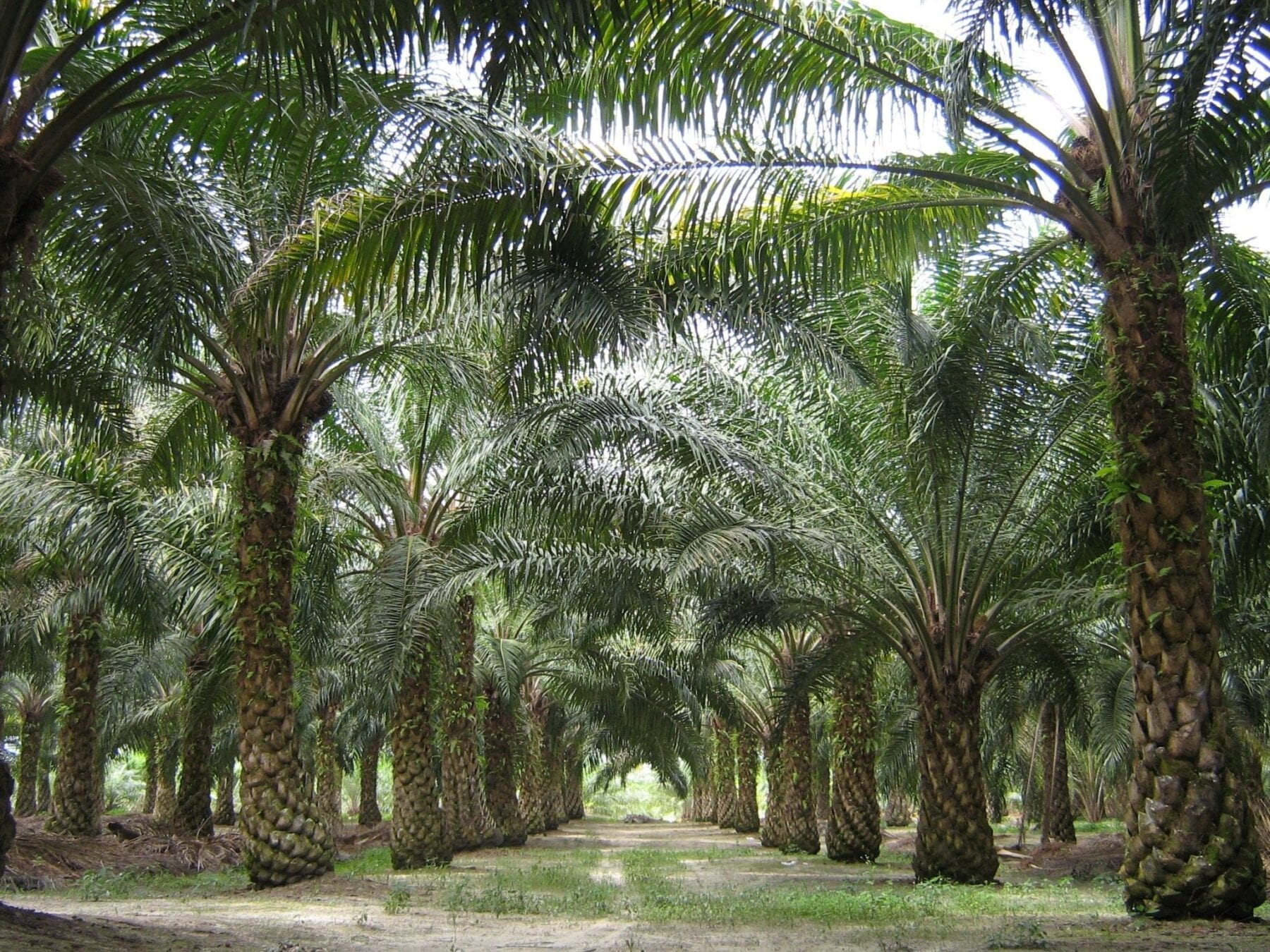
Miscanthus does almost as well in poor soils as in fertile cropland
The first long-term U.S. field trials of Miscanthus x giganteus, a towering perennial grass used in bioenergy production, reveal that its exceptional yields, though reduced somewhat after five years of growth, are still more than twice those of switchgrass (Panicum virgatum), another perennial grass used as a bioenergy feedstock. Miscanthus grown in Illinois also outperforms even the high yields found in earlier studies of the crop in Europe, the researchers found.
The average annual yield of Miscanthus grown in seven Illinois locations over a period of eight to 10 years was 10.5 tons per acre, compared with 4.5 tons per acre for switchgrass grown in side-by-side trials in Illinois, the researchers report. Miscanthus yields in Europe are about half of those reported in the Midwest.
The study took into account differences in yield that were the result of annual weather changes (primarily heat and precipitation, both of which increased growth).
The new findings appear in the journal Global Change Biology: Bioenergy. University of Illinois plant biology and Institute for Genomic Biology professor Stephen P. Long, who led the study, founded and edits the journal. The Energy Biosciences Institute at the U. of I. supported the research.
Miscanthus does almost as well in poor soils as in fertile cropland, Long said.
“That was the earlier finding in Europe and now we can confirm this for the Midwest,” Long said.
“It takes a little bit longer to establish Miscanthus in poorer soils, but once it’s established the yields seem to be almost as good as in the very best soils,” he said. The difference in yield between richer and poorer soils was less than 10 percent.
Several growers in the U.S. pelletize Miscanthus for use as a renewable, carbon-neutral energy source. The pellets are burned to produce electricity or heat. There is a growing market for pelletized Miscanthus in the U.S. and in Europe, Long said.
“However, the expected long-term and larger market for Miscanthus is in digesting the celluloses in the biomass to sugars for fermentation to ethanol and other liquid fuels,” Long said. “This would complement corn ethanol, since it would allow the use of land unsuited or marginal to corn and other row crops,” he said.
Long and his colleagues calculated the total land area needed to produce enough Miscanthus to meet the U.S. Renewable Fuel Standard mandate for cellulosic ethanol production by the year 2022. They found that the RFS mandate of 16 billion gallons (60 billion liters) of cellulosic ethanol by 2022 would require 17 million acres of Miscanthus x giganteus or 39 million acres of switchgrass.
“That 39 million acres sounds like a lot and is a lot, but keep in mind that the 48 contiguous states are almost 2,000 million acres,” he said. “We use only about a fifth of that in our row-crop agriculture – cotton, corn, soybean, wheat, etc. And we actually have at least 550 million acres that have been abandoned from agriculture in the last 150 years. This is not land that has been lost to urban sprawl.”
Because Miscanthus grows well in poor soils, it could be planted on former agricultural lands left unused after the Dust Bowl to prevent soil erosion, Long said. Or it could be grown on Conservation Reserve Program lands, agricultural areas left fallow to avoid farm surpluses in the U.S., he said.
“We have 40 million acres in the Conservation Reserve Program,” he said. “A crop like Miscanthus would be suitable for that land because it doesn’t have the same erosion problems of an annual crop. You’re not plowing the land every year, and you have a dense perennial root system that binds the soil.
“In fact, Miscanthus is arguably better than leaving this land fallow,” he said. “Not only is it a productive use, but the rapid growth of its root system will bind and improve the soil more rapidly. As well as being productive above-ground, Miscanthus was shown in Illinois to accumulate more roots over a period of five years than fallow land or even a native prairie ecosystem.”
An added advantage is that Miscanthus can be grown with little or no added fertilizer, he said. In the autumn and winter the nutrients drain out of the stems and leaves and are retained in the roots, stimulating new growth the following spring.
The Latest on: Bioenergy grasses
- Construction begins on groundbreaking precision ag research centeron May 10, 2024 at 10:07 am
Project builds on Nebraska U’s 100-plus-year relationship with USDA LINCOLN, Neb. — Construction of the National Center for Resilient and Regenerative Precision Agriculture at Nebraska Innovation ...
- Irish dairy co-operative seeks permission for biomass plantson May 9, 2024 at 1:12 am
Dairygold Co-operative Society, an Irish dairy co-operative based in Mitchelstown, County Cork, Ireland, is seeking planning permission for biomass plants at each of its sites in Mitchelstown and ...
- USDA enters partnership to create precision agriculture research centreon May 9, 2024 at 12:40 am
The USDA has partnered with the University of Nebraska-Lincoln to collaborate on a “ground-breaking” precision agriculture research centre.
- Daybreak: May 8: Vilsack to talk food with Newsom’s wife, billionaire donoron May 8, 2024 at 3:00 am
It is intended to serve as a research hub for precision agriculture technology, as well as wheat, barley, sorghum, forage and bioenergy grasses, ARS said.
- Construction begins on groundbreaking precision agriculture research centeron May 6, 2024 at 4:49 pm
Once fully completed, the agriculture research complex will function as a central hub for multidisciplinary experts, scientists and engineers who will collaborate with industry and producers to ...
- Plans afoot for invasive weeds to fuel a renovated modern biomass generator at Redbankon April 13, 2024 at 6:00 am
It's eroding the soil, it's not growing any grass for livestock or for biodiversity ... Verdant Earth Technologies CEO Richard Poole said bioenergy is "an untapped opportunity in Australia".
- New model integrates soil microbes, large perennial grasseson March 22, 2024 at 11:48 am
The growth of bioenergy feedstocks has great potential in this regard because these grasses both build soil carbon and have the potential to be used to produce carbon-neutral biofuels and bioproducts.
- Future Power: Where Will the World Get Its Next Energy Fix?on June 1, 2023 at 2:59 pm
At the National Bioenergy Center, scientists are trying ... Already, change is rising from the grass roots. In the U.S., state and local governments are pushing alternative energies by offering ...
- Farm walk will explore benefits of 'elephant grass' energy cropon January 28, 2022 at 3:34 am
The benefits of growing miscanthus bioenergy crops will be explored at a free Norfolk farm walk next week. Miscanthus, also known as "elephant grass", is a perennial bamboo-like plant which ...
- Sustainable Bioenergy: Genomics and Biofuels Developmenton August 8, 2012 at 5:30 pm
Unlike the easily processed sugars and oils in first-generation biofuels, lignocellulosic biomass consists of matter composed of the woody, inedible parts of plants, such as grasses, crops ...
via Bing News
The Latest on: Miscanthus
- Spring showers produce a kaleidoscope of greenon May 11, 2024 at 1:59 am
Violet-pink flowers grace the branches of the redbud tree (Cercis canadensis) in the spring garden. Pink tulips echo the redbud flowers, while sunlight illuminates the lamb’s ears, and hosta ...
- Let's Grow: Landscaping with ornamental grasseson May 10, 2024 at 2:12 am
Hardy grasses are perennials and will return each year larger. Here are some of our favorites: Miscanthus, commonly called “maiden grass”, has a very graceful habit, softly drooping and waving gently ...
- A Trial-and-Error Arcadiaon May 7, 2024 at 5:00 am
Early on, Hawks planted miscanthus grass atop the reservoir’s dam; it grows up to six feet and flowers in the fall. After a few years, she planted two rows of forsythia between the grasses so there ...
- Sunflower Fuels taps Cincinnati native as CEO to spearhead $4M fundraiseon April 29, 2024 at 3:39 am
The startup is looking to convert a perennial grass-like crop into sustainable aviation fuel. “It's a heavy lift, but this is the right region to do it.' ...
- Rain gardens and bathwater reuse becoming trends, RHS sayson April 28, 2024 at 9:00 pm
Chelsea flower show to focus on water reuse as gardeners prepare for shortages caused by climate crisis ...
- How to Grow and Care for Miscanthus (Silvergrass)on April 9, 2024 at 1:34 pm
Miscanthus, also commonly called silvergrass, is a genus of perennial, woody, and clump-forming warm-season grasses that are hardy, long-lived, and low-maintenance. The arching grass mounds ...
- How and when to cut back miscanthus – why your aesthetic and location can determine the timeon February 17, 2024 at 2:07 am
Miscanthus are fantastic, dependable, and low-maintenance ornamental grasses that come in a wide range of sizes and offer a wealth of benefits to a backyard space. Growing arcs of foliage topped with ...
- CRISPR Gene Editing Newson October 22, 2023 at 5:00 pm
They fine-tuned these tools to enable effective genetic screening ... Bioenergy: Precision Gene Editing in Miscanthus Jan. 19, 2023 — Researchers have successfully demonstrated precision gene ...
- New finance offer for miscanthus growerson May 12, 2021 at 7:00 am
FARMERS considering planting the carbon negative crop miscanthus can now access a finance package covering virtually all of their upfront costs for crop establishment. Oxbury Bank is working in ...
- Towering ‘elephant grass’ energy crop on show at Norfolk farmon July 24, 2019 at 2:47 am
Miscanthus, also known as "elephant grass", is a perennial bamboo-like plant which thrives on unproductive land, growing up to 12 feet high with the potential to yield 15 tonnes per hectare.
via Bing News










